
Want to start an online business but unsure whether to choose Printify or Shopify? These platforms cater to different needs of ecommerce businesses. While they might sound similar, they serve very different purposes.
Printify helps you create custom products without holding inventory, while Shopify powers your entire online store. Let’s explore which fits your business goals – or whether you need both to succeed.
What is Printify?
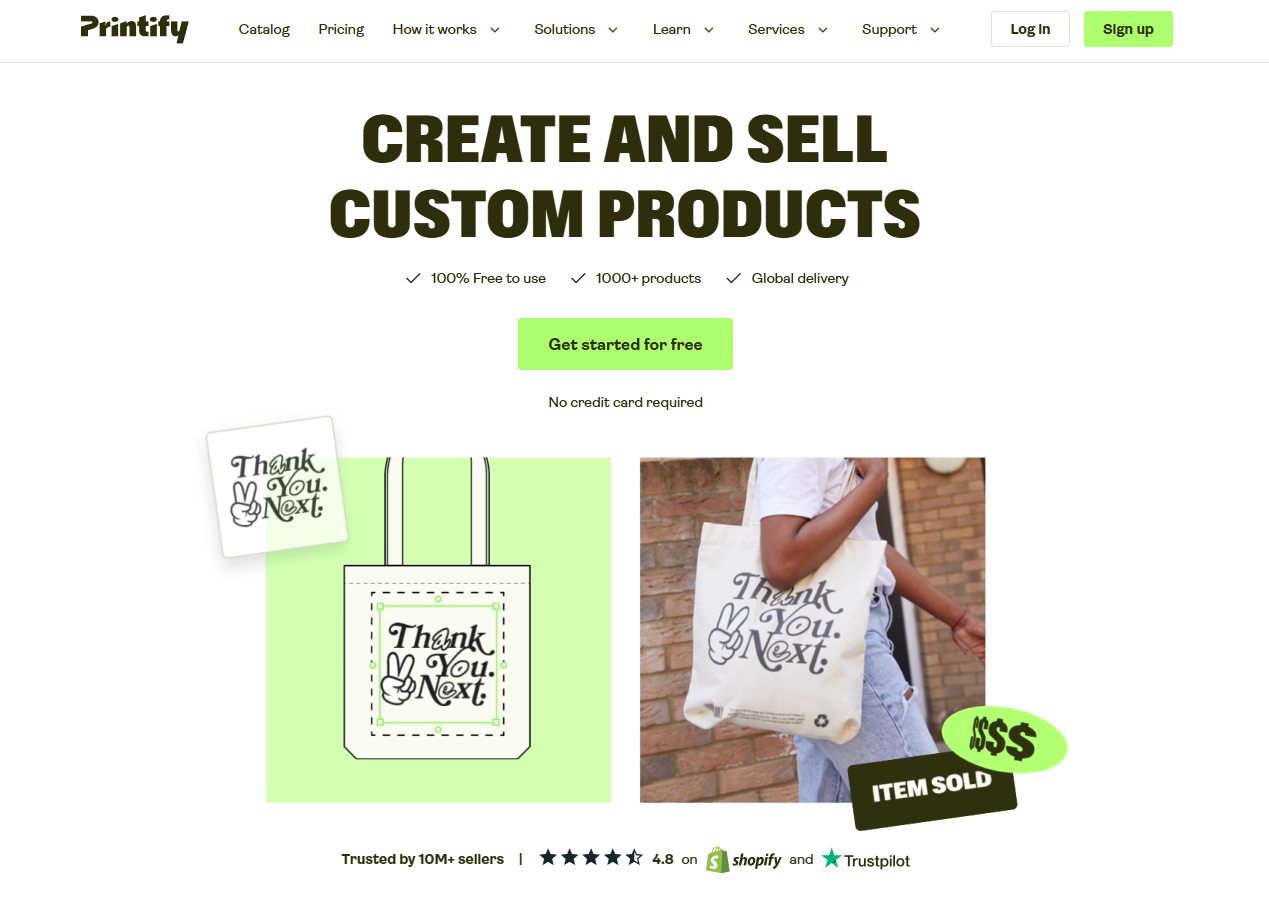
Printify is a global Print on Demand (POD) and fulfillment service platform. It allows merchants and individuals to print their designs on various products and sell them through multiple channels, including e-commerce platforms, independent websites, social media, and offline retail.
Through deep integration with e-commerce platforms such as Shopify and Etsy, Printify simplifies the entire process from design to printing to sales. This service reduces production costs and enables users to manage product inventory and logistics for seamless operations flexibly.
Printify Pros and Cons
| Pros of Printify | Cons of Printify |
| Rich product selection: Printify offers more than 900 customizable products, one of the largest POD product lines on the market. | Product quality varies: Since Printify has a large network of suppliers, the printing quality of different suppliers varies, resulting in different product quality. |
| Diverse supplier selection: More than 80 printing suppliers are provided, and selection is made based on various production factors, including location, shipping costs, production time, price, products, etc. | Lack of some important e-commerce platform integrations: Printify lacks built-in integrations with some important e-commerce platforms and marketplaces such as Ecwid, Big Cartel, Webflow, and Amazon. |
| Global delivery support: Printify supports global delivery, and merchants can choose the nearest supplier based on the customer’s location to optimize logistics costs and delivery time. | Limited product design tool functionality: Printify’s online design tool functionality is relatively limited and cannot support particularly complex designs. |
| E-commerce platform integration is not comprehensive enough: Lack of integration with some important e-commerce platforms, such as Ecwid, Big Cartel, and Amazon. | Limited global coverage: Although global shipping is supported, international shipping may take a long time due to differences in logistics companies and customs policies. |
| Automated order processing and logistics tracking: Orders are automatically passed to the Printify system, and then the corresponding suppliers are responsible for production and delivery, providing logistics tracking information. | Product printing areas are not standardized: Product printing areas are not standardized across all Printify suppliers, which may affect the conversion of designs to products. |
| Easy-to-use product creation tools: Printify provides easy-to-use product creation tools, making designing and customizing products simple. | Artwork file upload limitations: Other platforms allow larger artwork files to be uploaded, while Printify may have limitations. |
| Mockup generator: Printify’s mockup generator is handy when creating new products. |
What is Shopify?

Shopify is a comprehensive e-commerce platform designed to help users create and manage online stores. It provides a complete solution, including website hosting, payment processing, and order management.
In addition, Shopify also provides customized templates and sales tools to help merchants improve their business performance. The platform also integrates a variety of tools to enhance store functionality, making it an ideal choice for building an online retail business from scratch.
Shopify Pros and Cons
| Pros of Shopify | Cons of Shopify |
| Ease of use: Shopify is easy to use and suitable for people without a technical background, and its drag-and-drop tools make it easy to customize your store. | Higher costs: Shopify’s monthly fees and commissions on orders can be relatively high, especially for small merchants or startups |
| Professional templates: Shopify officially provides a template mall, which can be selected according to needs. The templates can be adapted to mobile terminals and compatible with various mobile devices. | Limited customization: While Shopify offers a plethora of templates and customization options, some merchants may still feel limited in terms of customization. |
| Stable and secure server: Shopify deploys free high-speed CDN around the world to ensure the security of transmitted data | Difficulty in migration: Once merchants have established their online stores on Shopify and accumulated a large amount of customer data, it may become quite difficult to migrate to other e-commerce platforms. |
| Payment processing: Shopify supports multiple payment methods and provides a safe and fast checkout experience | Transaction fees: In addition to your monthly plan fees, Shopify charges you transaction fees unless you use Shopify Payments |
| Powerful e-commerce features: From inventory management, order processing, payment gateway, and other life cycle management to SEO and marketing tools |
Printify vs Shopify: Pricing Plans
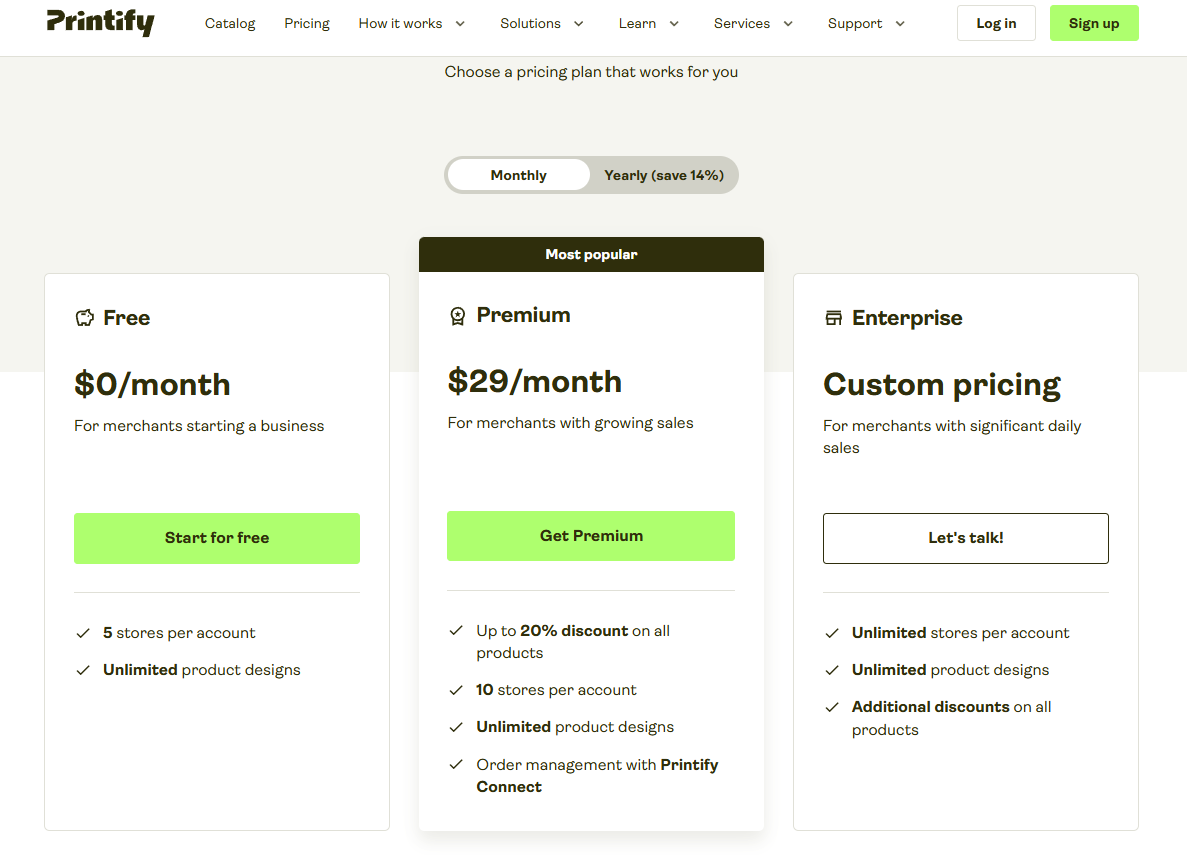
Printify’s Free Plan is perfect for new creators and small business owners who want to test the waters of a POD business. They can create up to five stores per account and have unlimited access to Printify’s product catalog and design tools.
Premium costs $29/month with a 14% discount when billed annually.
It also includes an additional 20% on all Printify products. The plan is suited to growing businesses ready to scale and allows merchants to set up ten stores per account. They also get access to enhanced order management tools.
Enterprise is recommended for large brands with complex needs. It is custom-priced and offers dedicated API support, bulk order discounts, and personalized account management.
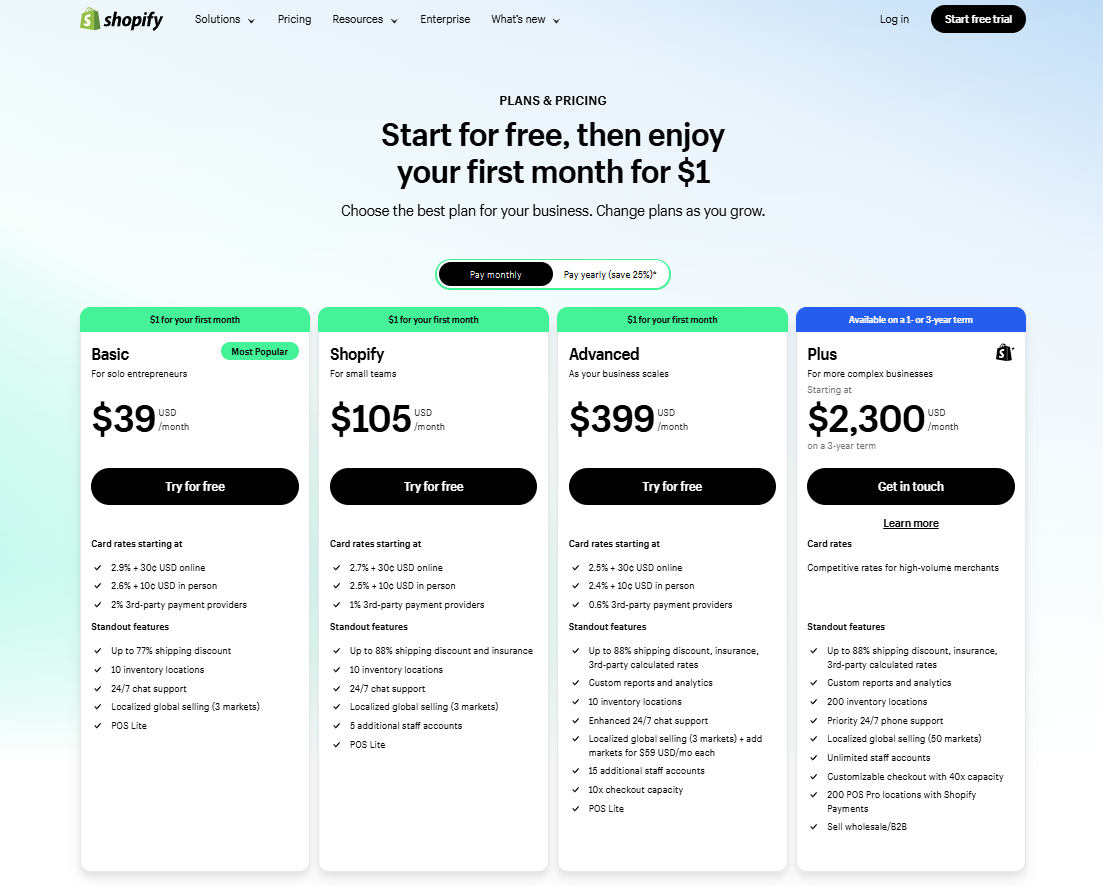
On the other hand, Shopify has flexible pricing tiers for businesses at different stages of growth. These include Basic ($32/month) for solo entrepreneurs, Shopify ($92/month) for growing businesses, and Advanced ($399/month) for scaling brands.
High-volume sellers and large brands that need dedicated account management and other priority features can subscribe to Shopify Plus, which starts at $2,300/month.
Shopify’s pricing is reflective of the whole e-commerce platform. For example, the POS (Point of Sale) system included with every plan allows businesses to integrate in-person and online sales, expand their reach, and unify their operations.
Although Printify is more affordable and perfect for POD entrepreneurs, Shopify justifies its higher pricing with more features, integrations, and scalability. It is best for businesses looking for a long-term e-commerce solution.
Read More: Shopify Pricing & Plans: Which Is The Best to Choose? [2024]
1. Printify vs Shopify: Ease of Use
Both Printify and Shopify boast user-friendly interfaces. Printify offers a streamlined platform focusing on print-on-demand services, making it simple for users to design, customize, and sell products.
Shopify is a more comprehensive solution providing tools for setting up and managing an entire online store with ease, catering to users with various skill levels.
2. Printify vs Shopify: Design and Customization
Printify Design and Customization
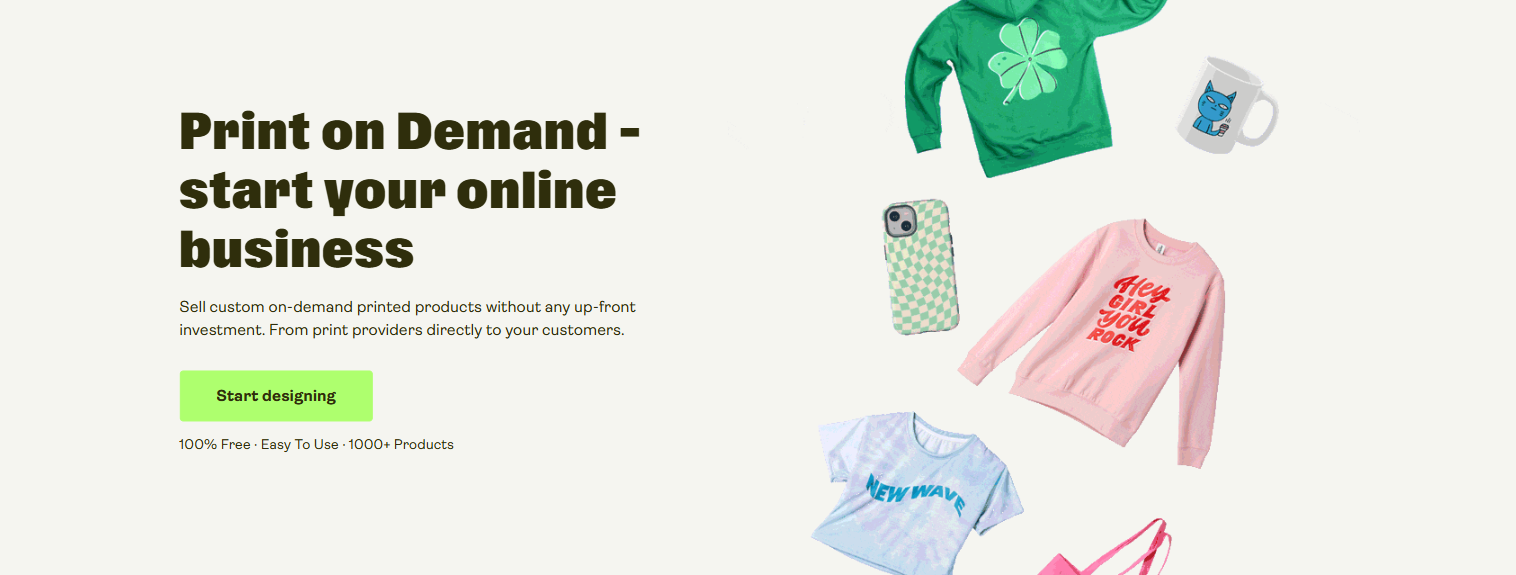
A well-designed online store is crucial for customer experience and building trust and loyalty. By comparing Printify vs Shopify design tools, we can see how they are designed to serve different types of e-commerce businesses.
Printify excels in product design customization so it’s perfect for creative entrepreneurs focused on print-on-demand (POD) merchandise. Sellers can upload artwork, logos, or custom designs and use built-in templates to customize products.
A standout feature is Printify’s mockup generator which allows users to see their design on products before listing.
For example, a user designing a T-shirt can upload their artwork, adjust the placement, and see a realistic preview of how the design will look on the final product.
This is super helpful for creating high-quality visuals and minimizing errors, especially for businesses that sell creative merchandise and rely on great images to sell.
Shopify Design and Customization
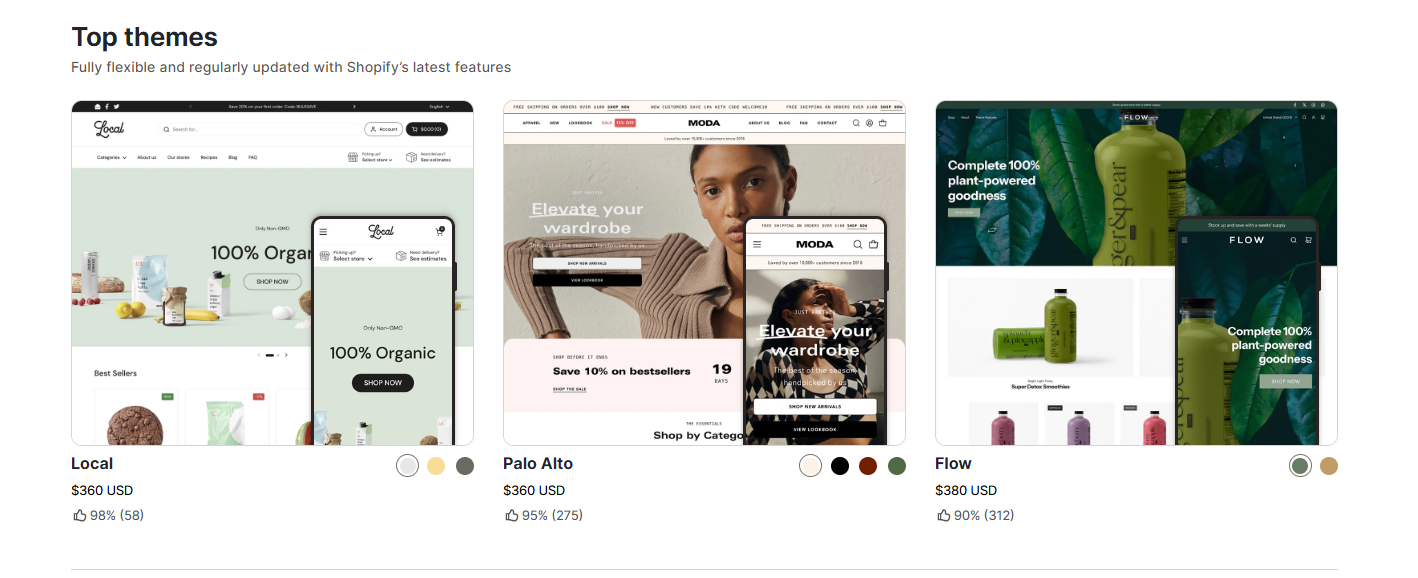
Shopify is great for merchants who want to build a professional-looking website that matches their brand. Its drag-and-drop builder makes it easy for users to adjust layouts, change fonts, and customize without needing technical skills.
For those with coding skills, Shopify’s platform allows for advanced customization so businesses can go beyond the standard templates and create a truly unique online store.
Shopify’s theme library, accessible through the Shopify Theme Store, has many options for different industries and branding styles. For example, the Dawn Theme is a minimalist, fast-loading theme perfect for showcasing high-quality visuals. Another option is the Debutify theme, which is a popular choice for beginners. It’s simple and comes with conversion-optimized features like product sliders and trust badges.
These themes can be customized further to fit specific branding needs. The Shopify app store has numerous tools to enhance design, such as image sliders, countdown timers, and pop-up banners that sellers can leverage.
For businesses focused on creating unique merchandise, Printify is the way to go for product-level design.
But for those who want to have a fully branded online presence, Shopify is the better choice.
Read More: Top 10 Free Shopify Themes to Promote Your Business [2024]
3. Printify vs Shopify: Payment Gateways and Fees
When it comes to payment gateways and fees, Printify and Shopify offer different solutions to meet the needs of various businesses.
Printify integrates with popular payment gateways, allowing customers to make transactions seamlessly. The platform’s transparent pricing structure ensures that you clearly understand the costs associated with each transaction, making it easier to manage your finances.
On the other hand, Shopify offers a versatile array of payment gateways that extend beyond the basics.
One of the standout features is Shopify Payments, an integrated payment solution that simplifies the checkout process for your customers.
With Shopify Payments, you can accept credit cards and other payment methods directly through your store, reducing the need for third-party payment processors.
Additionally, Shopify’s payment solutions extend to global markets, allowing you to reach customers worldwide. Transaction fees vary based on your subscription plan, with lower fees for higher-tier plans, making it a cost-effective option for growing businesses.
4. Printify vs Shopify: Product Offerings
Printiify Product Offerings
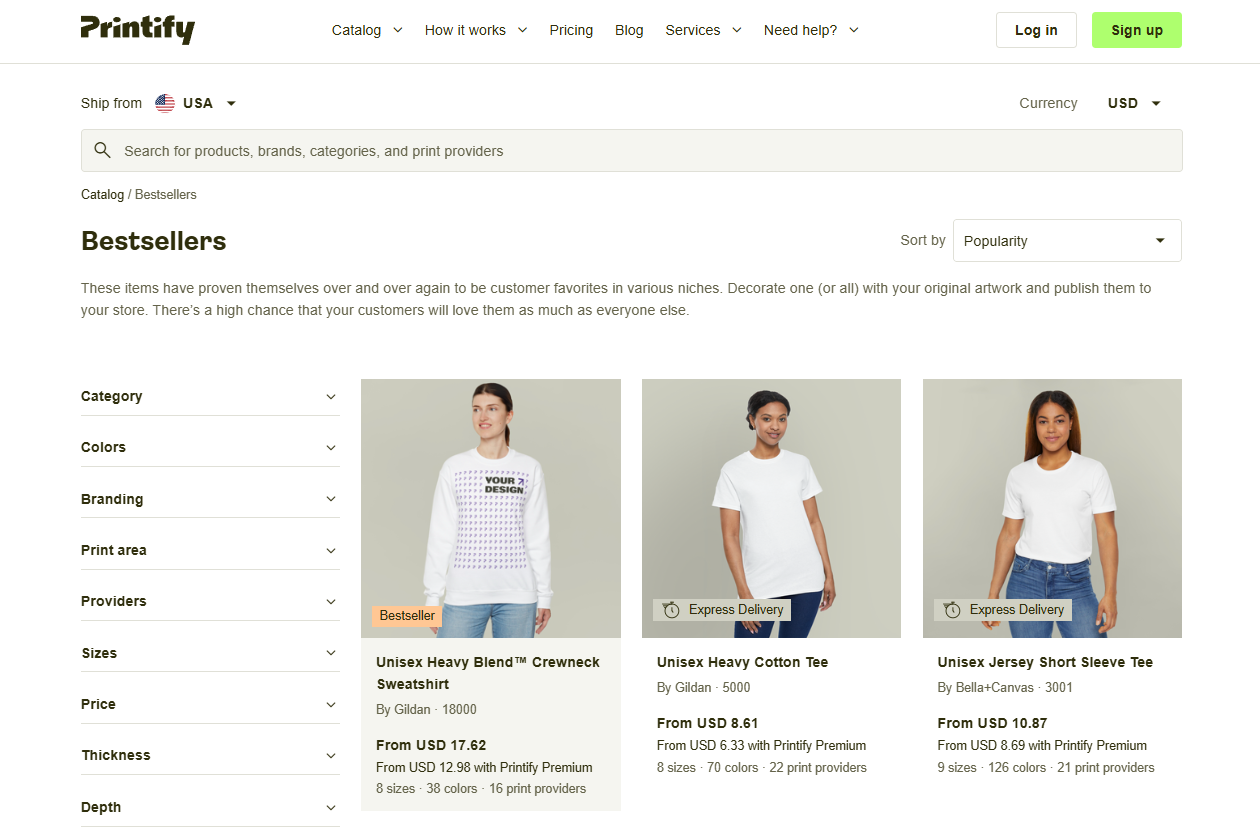
Printify is a print-on-demand (POD) platform with over 1,000 customizable products. These products fall into categories like clothing, accessories, home goods, tech gadgets, etc.
The platform is ideal for businesses with a design focus, like fashion brands, merchandise stores, and creators of custom-printed products.
For example, a designer launching a niche fashion line can use Printify’s wide range of apparel options, such as T-shirts, hoodies, and activewear to create a cohesive product line.
Businesses targeting specific markets like eco-conscious consumers can leverage Printify’s sustainable products like organic cotton apparel and reusable accessories.
Printify also has product mockup generators that enable creators to see their designs before listing them online.
Shopify Product Offerings
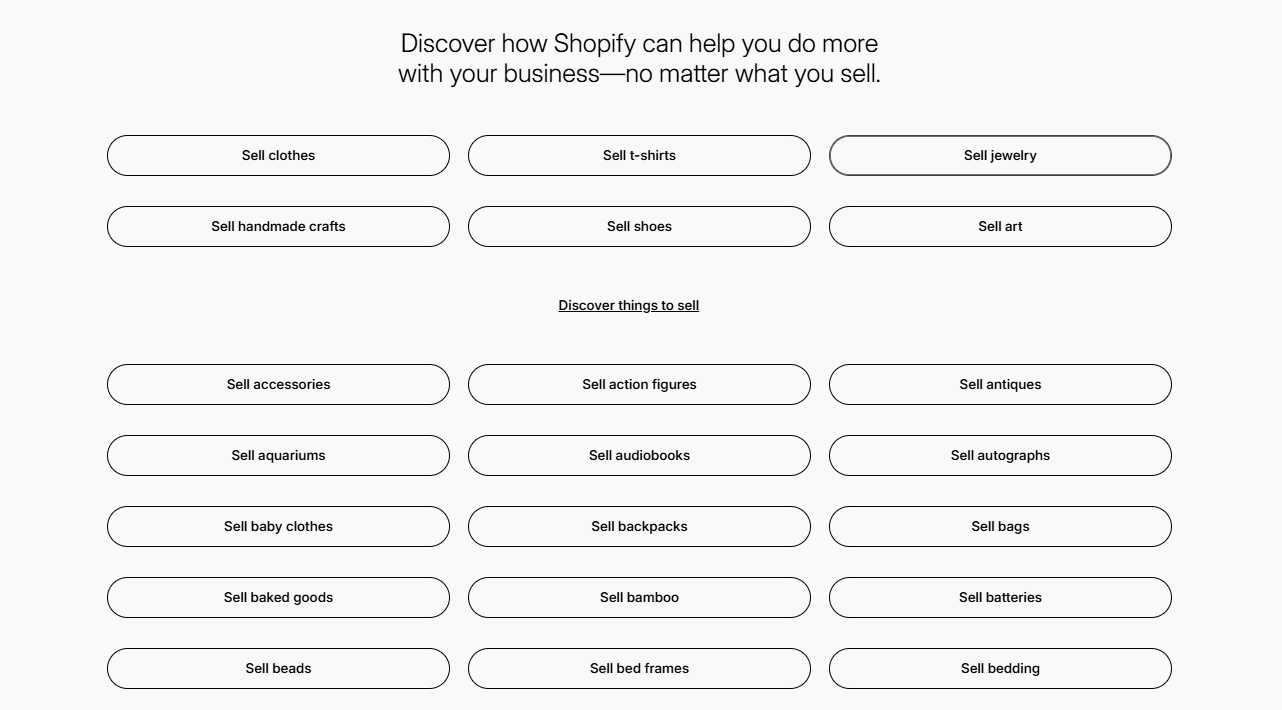
Conversely, Shopify is a general e-commerce platform for all types of products, so perfect for businesses across multiple niches or those wanting to expand their product range. Shopify supports:
- Physical Goods: Shopify has tools for businesses of all sizes selling physical products.
- Digital Downloads: Artists, educators, and content creators can sell e-books, music, courses, or software directly through Shopify’s platform. Apps like Digital Downloads make it even easier by automating product delivery to customers.
- Subscription Services: Shopify has recurring revenue models, enabling businesses to offer subscription boxes, memberships, or recurring services. Apps like Recharge make subscription management a breeze.
- Services: Service-based businesses like consulting, fitness coaching, or event management can use Shopify to promote, schedule, and manage appointments.
Shopify allows businesses to have multiple revenue streams and adapt to changing market demands.
For example, a business selling handmade candles can add digital tutorials on candle making or a monthly subscription box of curated home goods in the same Shopify store.
For businesses focused on print-on-demand, Printify’s specialization in customizable products and design-focused features is the way to go.
But for entrepreneurs who want to diversify their product range or sell across multiple categories, Shopify’s flexibility and support for multiple product types is the better solution.
5. Printify vs Shopify: Printing and Fulfillment Process
Printify Printing and Fulfillment Process
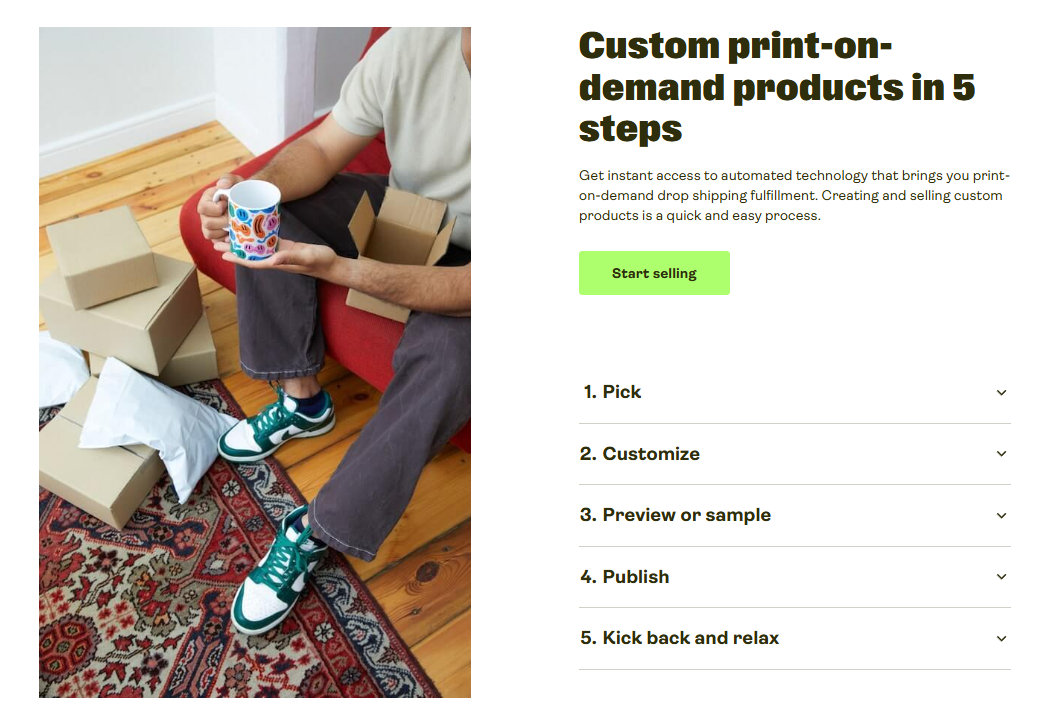
Printing and fulfillment are key to the success of a fully functional online store in the competitive print-on-demand (POD) market.
Printify simplifies the printing and fulfillment process for POD sellers. Its network of print providers is spread across multiple locations worldwide and has many customization options. Here’s how it works:
- Product Selection: Sellers choose from over 1,000 products, including T-shirts, mugs and home goods.
- Customization: Using Printify’s design tools, sellers upload artwork, create mockups, and select printing methods such as direct-to-garment (DTG), sublimation, and embroidery.
- Order Fulfillment: When a customer places an order, Printify automatically routes it to the selected print provider. The provider will handle production, packaging, and shipping to the customer.
Fulfillment times are 2-7 business days depending on product and location.
Since fulfillment is handled by third-party providers, businesses have limited control over quality assurance beyond choosing reliable providers.
Shopify Printing and Fulfillment Process
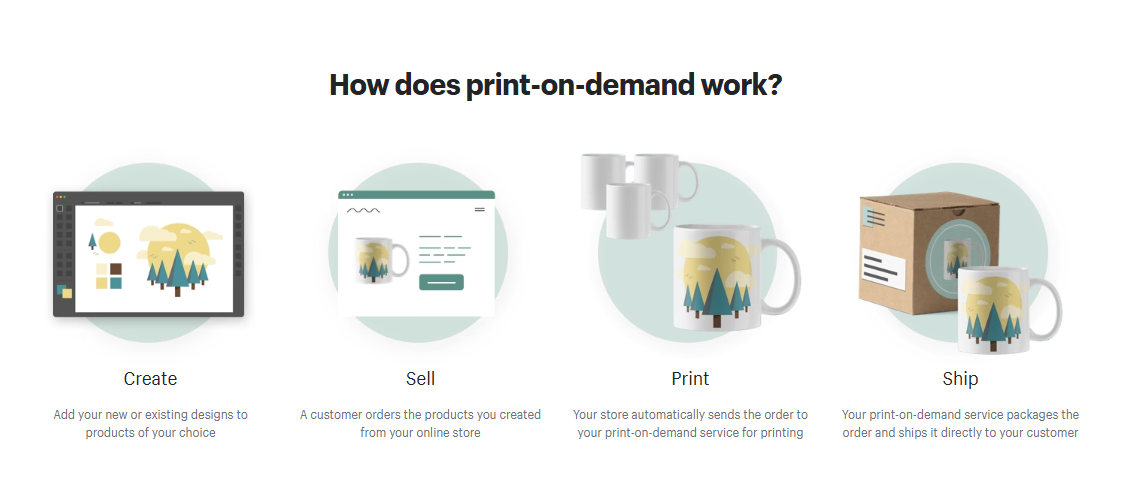
Shopify helps POD businesses significantly enhance their capabilities. The platform’s easy-to-use e-commerce solution means merchants can quickly set up fully customized stores and seamlessly connect them to various POD service providers.
Merchants can connect to Printify through apps in the Shopify app store. Once connected, orders from the Shopify store will be automatically routed to Printify for processing.
Alternatively, for non-POD products, Shopify’s Fulfillment Network gives access to third-party logistics (3PL) services. Merchants can store inventory in Shopify-managed warehouses and the network will handle picking, packing, and shipping for faster delivery.
To determine which platform is best for your specific business use the following key considerations:
- Delivery: Printify’s network has providers in different regions, so sellers can choose local manufacturers for faster delivery. For example, a US-based store can partner with a domestic provider to minimize shipping times. Shopify’s Fulfillment Network is better for merchants who need rapid fulfillment of stocked goods with expedited shipping options.
- Quality Control: Printify’s use of third-party printing providers can be a challenge for quality control. Sellers who prioritize quality assurance should vet Printify’s print providers by ordering samples. On the other hand, Shopify gives merchants more control when using the fulfillment network, as they can manage inventory standards themselves.
- Business Scenarios: A small fashion brand focused on unique and customizable apparel will benefit from Printify’s POD expertise. A multi-category store selling digital downloads, subscription boxes, and POD items will find Shopify’s integrations and inventory management tools more suitable for their business.
6. Printify vs Shopify: Inventory Management
Effective inventory management is essential to the growth and expansion of any e-commerce business, and both Printify and Shopify offer leading features in inventory management.
Printify streamlines inventory management through a user-friendly interface that provides insight into your product stock levels. This allows you to track your inventory in real-time, make informed decisions about restocking, and manage your product offerings efficiently.
Shopify, on the other hand, provides comprehensive inventory management tools that empower you to take charge of your store’s products.
With Shopify, you can perform bulk product uploads, track inventory across multiple locations, and receive low-stock notifications to ensure you never run out of popular items.
Additionally, Shopify’s advanced inventory solutions align with lean warehousing principles, helping businesses optimize storage, reduce waste, and improve order fulfillment efficiency.
The platform’s advanced inventory features also include options for managing variants, setting up automated restock alerts, and integrating with third-party inventory management apps for even greater control.
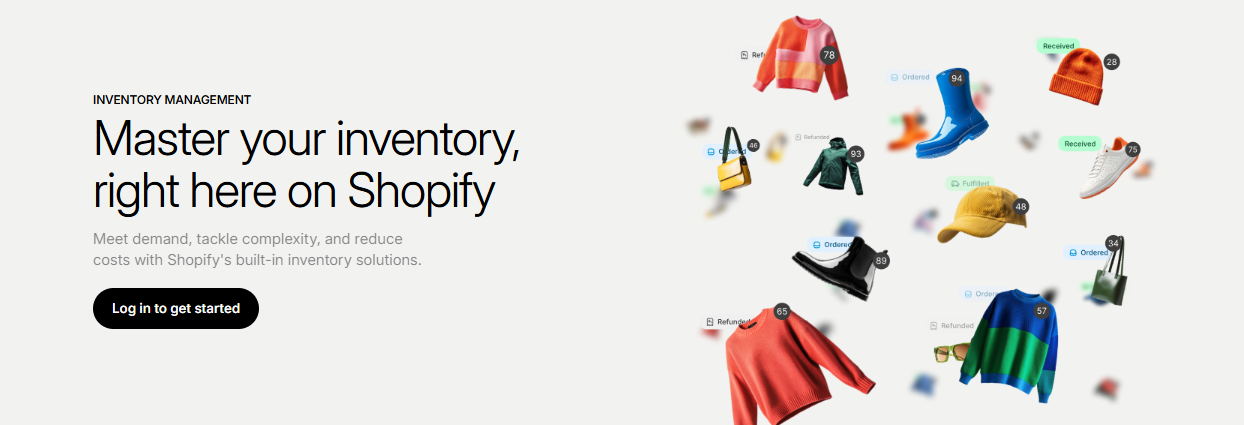
In summary, while Printify offers straightforward inventory management tailored to print-on-demand businesses, Shopify provides a more robust set of tools suitable for a wide range of ecommerce stores.
Whether you need basic inventory tracking or advanced management capabilities, both platforms have solutions to help you keep your store running smoothly.
7. Printify vs Shopify: Marketing and Sales Tools
E-commerce marketing tools help businesses attract visitors, convert them into customers, and build long-term loyalty. Printify and Shopify have different strengths in this area.
Printify’s marketing tools are limited but specific to print-on-demand (POD) sellers. Its mockup generator is a great tool to create professional product images with custom designs.
For example, a seller can use the tool to preview a mug design in different colors and create images for their online store or promotional campaigns. But beyond the mockup generator, Printify relies on integrations with platforms like Shopify, Etsy, and WooCommerce for marketing tools.
It is outdown by Shopify, which has built-in and integrated marketing tools for businesses of all sizes. Some of the tools Include:
- Abandoned Cart Recovery: Shopify will send follow-up emails to customers who leave items in their cart, a proven way to recover lost sales.
- SEO Optimization: Shopify’s SEO-friendly architecture will help your store rank higher in search results and drive organic traffic. Features like customizable meta tags, mobile responsiveness, and blog support also help increase visibility on search engines.
- Email Marketing: Tools like Shopify Email allow merchants to create campaigns directly within the platform, increasing customer engagement.
- Social Media and Sales Channel Integration: Shopify connects with Facebook, Instagram, TikTok, and Amazon, so you can sell on these platforms and manage everything in one dashboard.
Shopify’s analytics and reporting also give you insights into customer behavior so you can refine your strategy.
The impact of Shopify’s marketing tools on sales can be huge. Businesses using abandoned cart recovery tools can recover up to 15% of lost sales, and effective SEO can increase website traffic by up to 30%.
In conclusion, Printify’s marketing tools are limited and require integrations for more functionality. However, Shopify has a full marketing ecosystem that drives traffic, sales, and measurable ROI for e-commerce businesses. For sellers who want to build and grow a brand, Shopify’s tools are the best.
8. Printify vs Shopify: Integrations
Integrations are key for modern e-commerce, allowing businesses to extend their functionality and streamline operations.
Printify’s integrations are designed to help print-on-demand (POD) sellers by connecting with platforms, including integrations with Etsy, eBay, WooCommerce, and Shopify so sellers can tap into established marketplaces and their traffic.
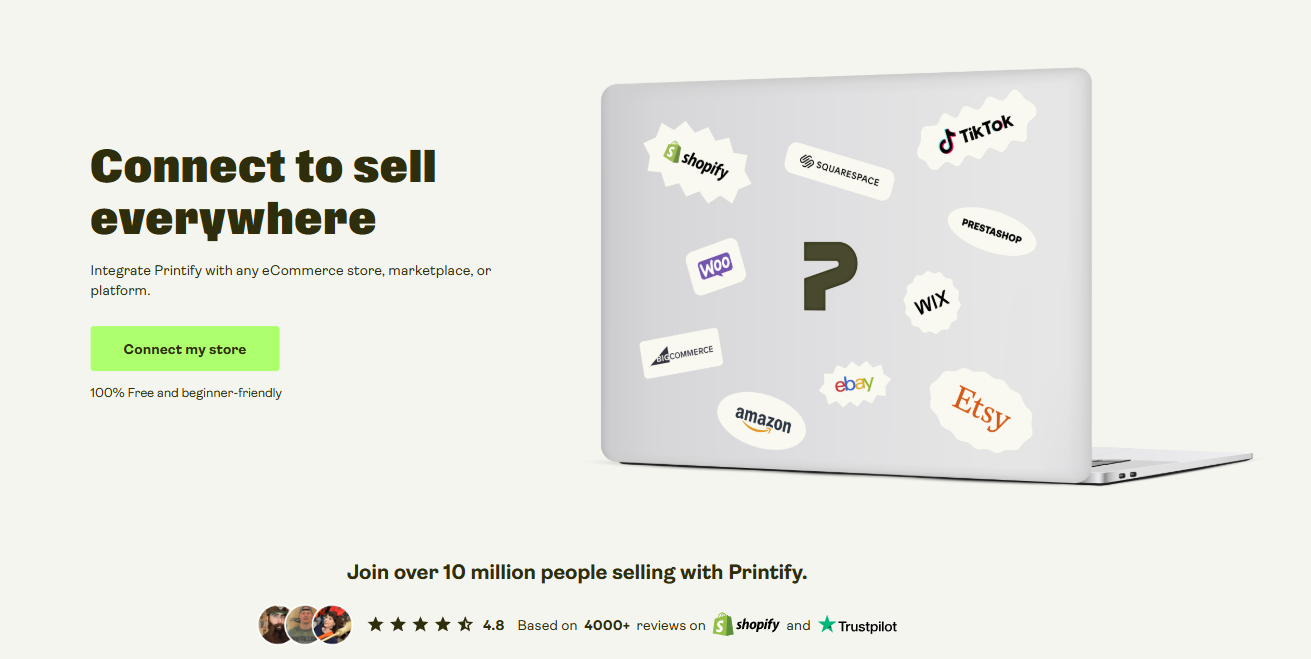
Comparatively, Shopify takes integrations further with over 8,000 apps in the App Store. These apps cover everything:
- SEO Optimization: Tools like Yoast SEO.
- Sales Channels: Integrations with Facebook, Amazon, and Instagram allow merchants to sell globally and reach more customers.
- Dropshipping Support: Tools like Oberlo make Shopify the go-to platform for merchants who want to add dropshipping to their POD offerings. For example, a Shopify store targeting international markets might use Oberlo for dropshipping and Printify for custom-designed POD products.

On the other side, Shopify is better for brands that need a full e-commerce suite. Whether it’s integrating analytics, managing inventory across multiple sales channels, or boosting marketing efforts, Shopify’s app ecosystem is unmatched.
9. Printify vs Shopify: Customer Support
Both platforms provide technical support for users. Shopify offers 24/7 support through live chat, phone, and email, while Printify provides email support and a help center with detailed articles and guides. Shopify’s broader range of support channels gives it an advantage in this category.
Printify vs Shopify: Which is Better for Your Ecommerce Business?
Choosing Printify or Shopify depends on your business needs.
If you’re looking for a print-on-demand solution focused on custom products, Printify is a good choice.
However, if you need a platform that offers a comprehensive e-commerce solution, including website building, marketing tools, and inventory management, then Shopify is undoubtedly a better choice.
Whichever platform you choose, it’s important to make sure it can support your business growth and meet your long-term goals.
What’s Next?
Printify and Shopify are two powerful platforms catering to different aspects of the e-commerce industry.
Printify specializes in print-on-demand services, enabling entrepreneurs to create and sell customized products without inventory management burdens.
Shopify, on the other hand, is a comprehensive e-commerce platform offering a wide range of features for building and managing online stores.
Shopify vs Printify FAQs
Note: This blog was originally written in English and translated using an automated tool to make the content accessible to a global audience. We believe in sharing valuable insights with everyone and apologize for any inaccuracies. If you spot any errors, please feel free to contact us for corrections. Your feedback helps us improve and ensures the content’s value is fully realized.





